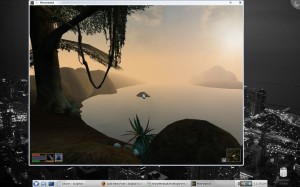Well, it’s been just over a month since I made the switch to Linux from Windows. My distribution of choice for desktop PCs has always been the fantastic Mandriva Linux. Available for free with plenty of included software (Open Office suite, the Firefox web browser, Kopete messenger, Amarok media player, and much more), it’s always done the trick and looks wonderful doing so.
I have two physical hard drives in my PC. The first one is mounted ‘/’ for all my system files and programs. The second drive is my ‘/home’ directory, where all of my documents are kept. All of the system files are kept entirely separate from my documents.This sort of division is done even with one single hard drive automatically by Mandriva so that if I ever need to format or upgrade the operating system I don’t lose any of my pictures, movies, or music, ever.

Life without Windows is certainly possible. I’m living proof. And the stuff I use my computer for is likely more intense than your average Joe since I’m a web developer. All of the required software that I use on a daily basis is available and runs great in Linux.
All of my games worked out-of-the-box using the Windows games and software emulator* (Read more about the Wine project). I’ve included a screenshot of me playing Morrowind. It runs great. My girlfriend and I played through Max Payne on this PC, as well, and we’re a quarter of the way through the Quest for Glory 2 remake (which is a lot of fun, by the way) on my other Mandriva Linux PC (our media center).
If you’re considering running Linux or if you’ve heard about it and are curious, give Mandriva Linux One a try. It’s pretty simple: You download it and burn it onto a blank CDR. Reboot with the disc in the drive and you can use it right off the disc without actually installing it. If you like it, go ahead and install it. Otherwise, just take the disc out and reboot — nothing has been changed on your computer.
For more information about Linux, try reading some of these sites:
* I realize Wine is technically not an emulator, but when explaining what it does it helps to use that term.
